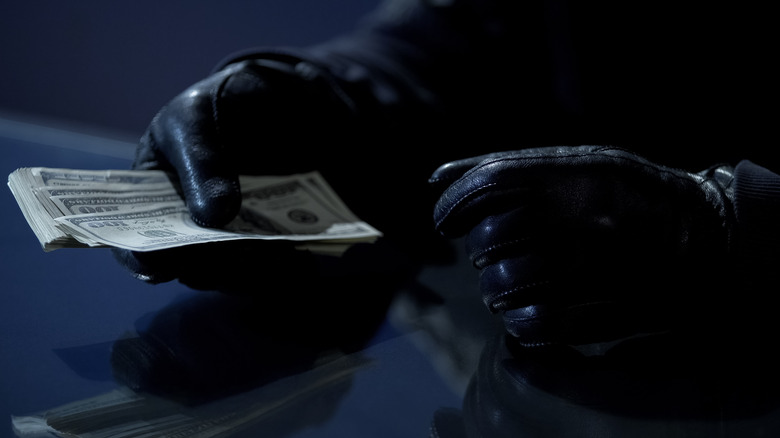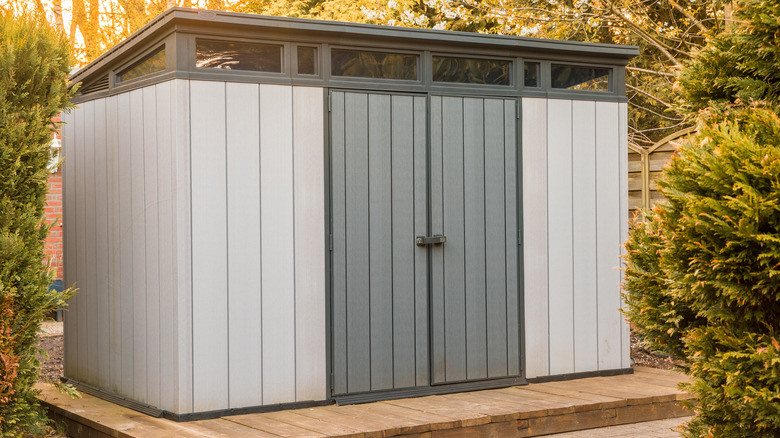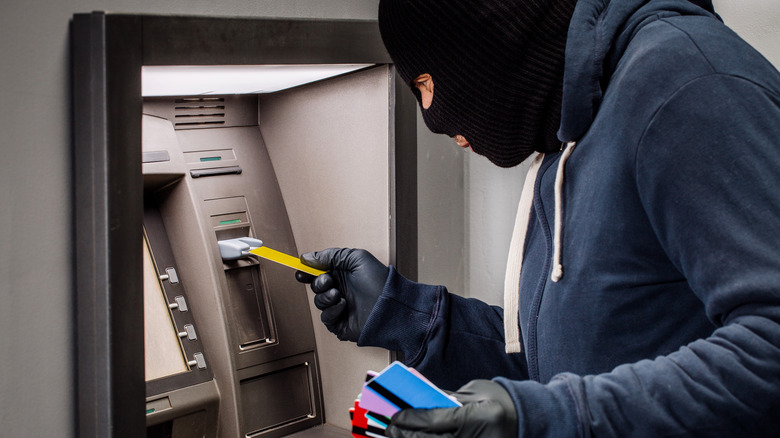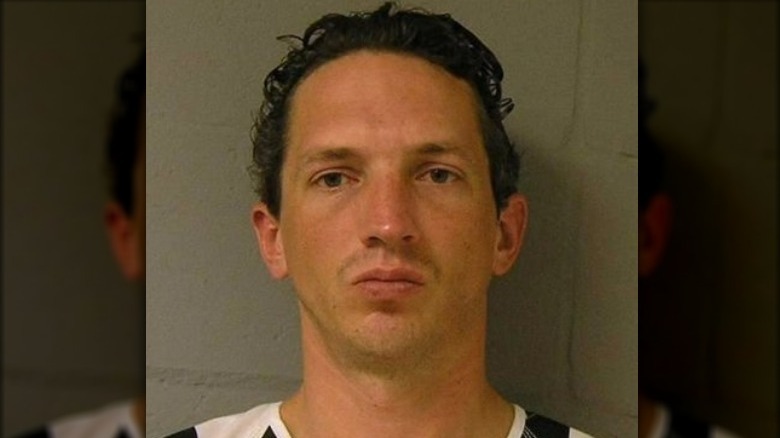How A Debit Card Led Police To Catch A Notorious Serial Killer
On February 12, 2012, The Brag Media writes, 18-year-old Samantha Koenig was working at the Common Grounds coffee stand in Anchorage, Alaska. An excerpt from "American Predator" by Maureen Callahan explains that unbeknownst to Koenig, Israel Keyes, a local man, had been eyeing the coffee stand for weeks (per the New York Post). ABC News explains that he later admitted to authorities that he only planned to commit a robbery. Instead, however, he decided to kidnap and murder Koenig. This is because Keyes was not an average burglar; he was a serial killer. Biography reports it's believed he killed up to 11 people prior to his arrest in 2012.
Per the Anchorage Daily News, Keyes was born in Utah to a devout Mormon family. The Keyes family eventually moved to a rural area in Washington State where they became associated with white supremacists (via Biography). They later moved to Oregon and Maine. Despite their zealous background, All That's Interesting states that there were warning signs when it came to Israel's behavior in his early years.
In an interview with investigators, Keyes stated that "I've known since I was 14 that ... there were things that — that I thought were normal and that were okay that nobody else seemed to think were normal and okay" (via CBS News). This included torturing animals and stealing guns from people's homes.
Israel Keyes crimes began in the late 1990s
ABC News writes that Keyes' first violent crime occurred between 1996 and 1998. He admitted that he had raped a teenage girl in Oregon but had spared her life. After this incident, the Anchorage Daily News states, he promised himself that he "was never going to let that happen again." In other words, his intention was to kill. Per CBS News, Keyes joined the army in 1998 and served until 2001. That same year, he began his murder spree, which would last for over a decade (via All That's Interesting). Keyes later admitted that he had killed multiple other people across a number of states prior to Koenig's murder (per Oxygen).
Although several of his victims remain unnamed, Biography explains that besides Koenig, it's known that he killed Bill and Lorraine Currier, a married couple that lived in Vermont. According to The Brag Media, Keyes broke into their home in June 2011. He then drove the Curriers to an abandoned farmhouse where he brutally shot Bill and strangled Lorraine. Additionally, Keyes disclosed that he had sexually assaulted Lorraine before he murdered her.
Oxygen reports that their bodies have never been found. In fact, if Keyes had not confessed to the crime, it's unlikely it would have been solved. Unlike other serial killers, he did not have a specific victim he sought out. Keyes chose who he killed at random and in different locations (per All That's Interesting).
He got away with murder for years
All That's Interesting explains that Keyes' distinct modus operandi allowed him to kill while staying anonymous. The Brag Media writes that no one was off-limits except for children and people who had kids. This is because Keyes was a father and had a daughter. Nonetheless, he was as ruthless as they come. Per Biography, Keyes traveled throughout the United States in order to find victims and murder them. Moreover, once he killed somewhere, he never returned to the area, allowing him to disappear without consequence. In regards to the Curriers, Oxygen states that Keyes flew from Alaska to Chicago and rented a car. He then drove to Vermont where he senselessly killed the couple.
Keyes also took various trips in order to stash murder kits throughout the country (via ABC News). Inside Home Depot buckets (per CBS News), he placed money, an array of weapons, and other items to properly dispose of his victims. The Brag Media reports that one of these kits was buried prior to the Curriers' murder, near their home. Some of his kits were later found in New York and Alaska.
Additionally, Keyes, a construction worker, paid in cash while he was on these trips and turned off his cell phone to avoid detection. ABC News affirmed that he financed his kill trips and kits using money from bank robberies. However, the beginning of the end was set in motion when Keyes murdered Koenig. The methodical killer made a mistake and used her debit card at an ATM.
Samantha Koenig was Keyes' last victim
According to The Brag Media, Keyes told Koenig he was kidnapping her for a ransom. He quickly realized that the teen did not have her phone or debit card on her, both of which he needed for his plan to work. Alaska Public Media writes that Keyes returned to the coffee stand for her phone. He then texted her boyfriend and boss that she was going out of town for the weekend. Keyes returned home and locked Koenig in a shed at his house. Afterward, he drove to Koenig's boyfriend's home to get her debit card, which she stated was in her boyfriend's truck.
Per The Brag Media, the boyfriend actually witnessed Keyes breaking into the truck. However, he believed that Keyes was trying to steal the vehicle and he went inside his home to call for help. Keyes fled and returned to the shed. CBS News reports that he proceeded to sexually assault and strangle Koenig. She would be his final victim and his undoing.
Only hours after the murder, Keyes, his daughter, and his girlfriend left to go on a trip (via Oxygen). Keyes left Koenig's body inside the shed for over two weeks (per Alaska Public Media). Once he returned home, he planned to get the ransom he originally wanted. Keyes took Koenig's lifeless body and sewed her eyes open to make her look as if she was still alive (via The Brag Media).
The ransom that led to Keyes' downfall
Keys took a photo of Koenig holding a recent newspaper and typed out a ransom note demanding $30,000 (per Alaska Public Media). He then placed the photo and the ransom in a nearby park and texted her boyfriend. Koenig's father came up with the ransom money and deposited the funds into the account that was linked to her debit card. By then, CBS News writes that Keyes had dismembered and dumped her body into Matanuska Lake. Shortly after, he left Alaska, per ABC News.
Alaska Public media reports that authorities decided that their best course of action was to track the activity on Koenig's card. Perhaps this could lead them to a suspect — and they were right. ATM withdrawals were subsequently made in New Mexico, Arizona, and Texas. Authorities figured out that whoever was making these withdrawals was driving a white Ford Focus (via The Brag Media). On March 13, 2012, Oxygen states that a state trooper encountered a vehicle similar to the one that was being sought.
Authorities pulled the car over and found Keyes inside with Koenig's debit card, her phone, and other incriminating items. He was subsequently arrested and began to speak to investigators about his crimes (via All That's Interesting). Keyes admitted that he knew had made several mistakes regarding Koenig's murder. He stated that he had lost a "massive amount of self-control" (per ABC News). Keyes never killed anyone in the city he resided in and divulged that he only wanted to rob Koenig. In the end, he "broke his own rule," which led to his capture.
Israel Keyes never went to trial
Per CBS News, Keyes spent seven months behind bars speaking to authorities about his double life and his previous crimes. Oxygen writes that he admitted to Koenig's murder and that of the Curriers. However, investigators believe he was the perpetrator behind various crimes throughout the country, including in Oregon, Washington, and New York. Keyes divulged some information, but not enough to know for sure. Even so, investigators believe there were possibly 11 victims in total. On December 2, 2012, Israel Keyes committed suicide in his jail cell, taking any information about his victims and crimes to the grave (via The Brag Media).
MyNorthwest reports that Keyes slit his wrists and used a bedsheet to strangle himself. He avoided facing a trial for his crimes against Koenig and the Curriers. The Brag Media reports that his suicide letter mentioned his unnamed victims, but neither their identities nor clues as to where their remains could be found. According to MyNorthwest, a small funeral was held in Deer Park, Washington, for the 34-year-old days after his death. His mother and his sisters attended the service, conducted by their pastor, Jake Gardner.
If you or someone you know is struggling with mental health, please contact the Crisis Text Line by texting HOME to 741741, call the National Alliance on Mental Illness helpline at 1-800-950-NAMI (6264), or visit the National Institute of Mental Health website.





